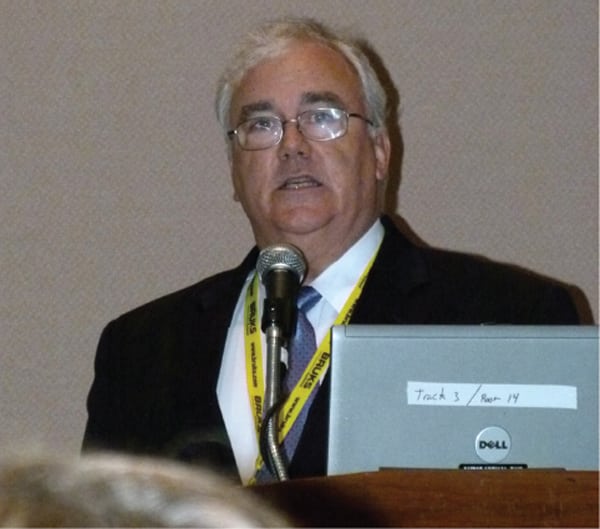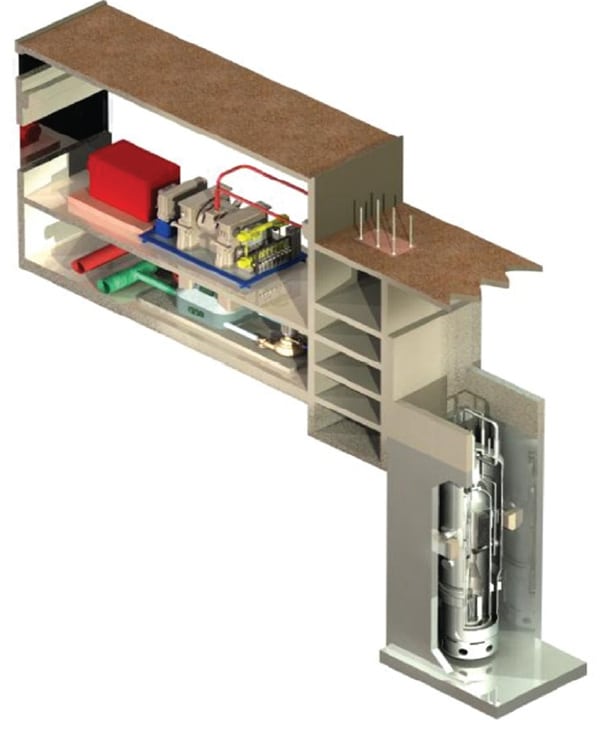Nuclear Power in the Shadow of Fukushima
Risk, risk management, and the specter of Fukushima ran through the nuclear track at May’s ELECTRIC POWER Conference in Chicago. The reality of risk, driven home by the horrendous events in Japan, was a recurring theme in many presentations, in questions to speakers, and in the conversations among delegates during informal moments.
Sargent & Lundy’s William Peebles kicked off the two-day nuclear energy track with a description of what occurred in Japan on March 11 and the current assessment of the scope of the damage. As he spoke, the toll of the earthquake and tsunami was again rising. Peebles noted that the four damaged reactors at the Fukushima site took a one-two punch, leading to the dreaded condition known in the nuclear world as “station blackout,” a loss of electric power that totally disables safety systems. First, a massive earthquake hit the Japanese coast, calculated as a 9.0 event, far beyond what Japan had seen in recorded history. That took out offsite power to the site. Then, administering the knockout blow, a tsunami with waves topping 10 meters—another unprecedented event—smashed into the site, killing on-site backup diesel generators and preventing rescue crews from reaching the plant.
The resulting explosions, melting fuel, spread of radiation, and enormous population evacuation established Fukushima as the second-worst disaster in the history of civilian nuclear power, after the Chernobyl explosion in the Ukraine almost exactly 25 years earlier. It also provided a chilling backdrop to the discussions in Chicago. Throughout the meeting, those who follow nuclear power were discussing just what might befall the nuclear industry in Japan as a result. Some thought that Tokyo Electric Power Co. (TEPCO), the reactor operator and owner, would survive with government backing. Others were convinced that TEPCO was not “too big to fail” and would not outlast the reactor disaster.
For the developers and operators of nuclear power plants, risk is not just a matter of the odds that a plant could fail catastrophically, as in Japan, at Chernobyl, or at Three Mile Island in 1979. Risk arises at the very beginning of planning a nuclear venture. Economic and engineering risks prevail in planning and building these incredibly complex, wonderfully useful machines for making electricity. These are risks in slow motion, but they are real and significant nonetheless.
Small-Scale Developments
The nuclear track included a popular section on the “big new thing” in nuclear: little reactors. The atomic acronym is “SMR,” for “small, modular reactor.” Reduced risk to public health and safety has long been a selling point for the SMRs. Incorporating a full range of passive features to slow down an accident scenario and make response and recovery easier, the SMRs look very good on paper. (See “Are Small Reactors Better?” in the November 2010 issue of POWER, available in our archives at https://www.powermag.com.)
Imagine a fission reaction in a large, steel thermos bottle (we’re not talking cold fusion here, but hot fission). That’s NuScale Power, the product of a U.S. Department of Energy research team involving Oregon State University, the Idaho National Laboratory, and a former Bechtel subsidiary. The 45-MWe pressurized water reactor encloses all the conventional innards of a large reactor in a 65-foot-tall, 14-foot-diameter tube, with the air evacuated to leave a vacuum. In a commercial plant, several of these vacuum bottles would sit in a below-ground pool containing 4 million gallons of water—an additional safety barrier and a shock absorber in the case of an earthquake (not unknown in Oregon, where NuScale makes its home). A concrete shield covers the pool and contains any contaminants.
“The thermos bottle concept is completely novel,” NuScale Power’s Ed Wallace told the power expo (Figure 1). Wallace, senior vice president for regulatory affairs, joined NuScale a year ago, after several years working on the unsuccessful pebble bed modular reactor project at Chicago’s Exelon and South Africa’s PBMR Pty. His job at NuScale is to serve as shepherd and sherpa, guiding NuScale’s design through the risky waters of the U.S. Nuclear Regulatory Commission’s (NRC’s) licensing process. Wallace described the concepts underlying the licensing of new, unique reactor technologies, the challenges these new technologies present, and the need to get designers, developers, and regulators speaking the same language and understanding the technology (Figure 2).
 |
| 1. Small is beautiful. NuScale Power is developing a small, modular nuclear reactor. Ed Wallace is senior vice president, regulatory affairs for the company. Source: POWER |
 |
| 2. Nuclear building blocks. The NuScale Power module uses pressurized water reactor technology with passive safety systems to produce 45 MWe. The small, modular reactor would be refueled every 30 months using 4.95% enriched UO2. To give a sense of scale, the reactor vessel is only 65 feet tall. Multiple units can be built and aggregated to meet any power requirement. Courtesy: NuScale Power |
Probabilistic risk assessment (PRA), Wallace said, is a key to answering the complex and intertwined licensing issues. The PRA for the NuScale project, he said, offers a way to focus analysis, make sure the right questions are asked and answered—illuminating the “unknown unknowns”—and give muscle to the familiar concept of defense-in-depth. “The real value of PRA is in the journey,” he said. The PRA, he said, “adds robustness” to the design.
Regulating Nuclear Power
Wallace noted “a whole lot of emerging issues growing out of Fukushima.” Stephanie Coffin of the NRC described some of those issues that confront regulators. Her fundamental advice to those planning these new reactor technologies: “Potential applicants should engage NRC early with specific proposals”—advice she repeated throughout her presentation.
One of the issues that arose in Japan, and that the NRC wants addressed for the SMRs, is the size of emergency zones around the plants. Most large, conventional reactors are located away from population centers, but they also contain much larger inventories of radiation products in their cores. SMRs—particularly if they can be used in cogeneration and district heating applications along with power generation—are likely to be located closer to populated areas, but they’re also likely to possess lower concentrations of poisons in the core.
Another emerging issue is control room staffing. Current NRC rules limit the number of reactors an operator can control to two. SMR installations may consist of arrays of half a dozen or more units controlled by one operator. This, too, troubles some at the NRC.
The appropriate NRC licensing process for small nukes is also on the regulatory table. There are two paths toward a final operating license. NuScale plans to submit an application for NRC certification of its reactor design in 2012 under the commission’s generic program (known as Part 52 for its location in the Code of Federal Regulations), hoping for approval in 2019. This is a “one-stop” process that envisions a preapproved reactor design. The Tennessee Valley Authority, on the other hand, is working with Babcock & Wilcox (B&W) and Bechtel to put a B&W mPower SMR on TVA’s Clinch River site in Tennessee under the NRC’s traditional, two-step “Part 50” licensing process.
The NRC is agnostic about which process should be used. In either case, Coffin assured the audience that the agency “is preparing for a high level of advanced reactor licensing activity” and that the NRC “will review applications in a timely manner.”
Risk Assessment Wrap-up
Booz & Co. Vice President Christopher Dann summed up the developmental and regulatory risks to nuclear power posed by events in Japan. “The oldest plants and those most believed to be exposed to natural ‘black swan’ events” such as hurricanes, floods, and other improbable catastrophes, he said, “will face the stiffest review; new plants should expect more local opposition if ‘greens’ and ‘fatalists’ argue for a moratorium.” Ultimately, he said, the impacts of Fukushima “will depend on the state of the plant, the nature of the technology, the national stance towards future nuclear power and the options available as alternative fuel sources.”
Perhaps the greatest risk to the future of nuclear power in the U.S., said Dann, lies entirely out of the control of the nuclear industry and its regulators. “Natural gas prices,” he said, “drive the fundamental economics” of new nuclear power.
— Kennedy Maize is a contributing editor to POWER and executive editor of the online magazine MANAGING POWER.